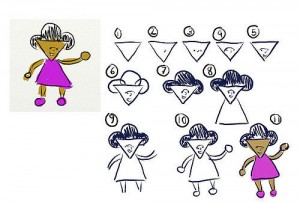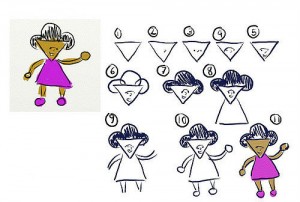 Many of my students tell me that they chose to study voice-over because they love doing character voices. After we chat about it, they offer to perform their favorite character voice. Oftentimes, it’s their version of a famous cartoon character. While they do a good job, I have to break the bad news that their amazing Homer Simpson impression probably won’t find them work because that particular voice has already been taken. I do encourage them to explore new and fresh characters. I can hear the talent in their performance, we just need to supercharge the creativity. Their next question is, “How do I do that?” I think every voice-over artist has his or her own formula to achieving a unique sound and developing their voice-over character. Here are a few ideas about how to develop your voice-over character:
Many of my students tell me that they chose to study voice-over because they love doing character voices. After we chat about it, they offer to perform their favorite character voice. Oftentimes, it’s their version of a famous cartoon character. While they do a good job, I have to break the bad news that their amazing Homer Simpson impression probably won’t find them work because that particular voice has already been taken. I do encourage them to explore new and fresh characters. I can hear the talent in their performance, we just need to supercharge the creativity. Their next question is, “How do I do that?” I think every voice-over artist has his or her own formula to achieving a unique sound and developing their voice-over character. Here are a few ideas about how to develop your voice-over character:
A great way to explore and put yourself out there when you are just starting out is to do a bad impersonation of your favorite movie star (or a very well-known actor). Maybe someone like Marilyn Monroe, John Wayne, Tom Hanks, Johnny Depp, or Clint Eastwood. Try mimicking them. Who knows, you may come up with your own sound! At the very minimum, it will loosen you up and you can have some fun exploring what you can do with your voice.
Choose some traits and personality quirks for your voice-over character. Are they mean, sweet, intelligent, sassy, dumb, spoiled, or lazy? The list is endless. The more you know about your voice-over character, the more convincing you’ll be. Angelica, on The Rugrats, is extremely spoiled, self-centered, bossy, and bold. The bespectacled aardvark, Arthur, of the PBS series Arthur, was a somewhat shy, awkward, but popular, 8-year-old boy. He had a sweet sensitivity about him while Angelica bulldozed her way through life. Knowing your character’s personality will put you on the right track for inventing a believable character. This is similar to actors creating a backstory for characters they are playing in film/TV. It will help you make strong compelling choices.
Decide where your voice is coming from. Try speaking from the back of your mouth and then the front of your mouth to hear the differences. Try a nasal sound. Experiment with a lower register, then try going to a higher one. Make notes on what is and isn’t working.
Use images. If I am provided with an artist’s rendition of the character, I go with that. If not, I’ll look for images on Google and find something that motivates me. For example, you are almost always provided with a drawing of the character in video game auditions. I audition a lot for warrior princesses so if the character’s picture has a 10-inch waist, flowing hair, and a sword, I immediately add sass and attitude to my voice. If she has a high ponytail, pink jewelry, and innocent round eyes, then I add a sweet, cute, and bubbly voice to her dialogue. I have voiced animal characters for ESL programs for children without being provided any photos. I ended up googling “cartoon baby duck,” or “cartoon baby elephant,” and from looking at those cute little animals, I was able to create a read that matched the personality I had created in my mind.
Last but not least, practice sustaining your new voice-over character. In most cases, you will be asked to do several voices when you are hired to provide a voice for an animated project or a video game. I’m usually asked to provide three or four voices. There was this one project where I voiced every animal in the series including the mother of a panda. Luckily for the mother’s voice, I was able to use my natural voice but it was still challenging to find a unique sound for each animal. Once again, this is where images really help. I printed the images and put them up on my wall behind my microphone, so I could immediately lock into character and stay with that sound and personality.
Being able to create a large repertoire of voices will serve you well if you end up booking a lot of work in the animation world. Last year, I attended a Q & A at Warner Entertainment and the casting director on stage told us that once you became known for a certain character voice on a series, that sound basically belonged to that particular studio. For example, if you create a character for a Disney network cartoon series, you cannot take that voice to Nickelodeon and use it there. You need to come up with an all-new sound. So, practice now to come up with that bevy of award-winning voices. And remember to have fun!
Find this helpful? You can find topics like this in our VIP Membership program.
There are two other ways in which you can tune into our blog!
You can access the audio version of this article on the Such A Voice Soundcloud.
We’re also on YouTube. Check out the video for this post:
About the Author
Jan Haley-Soule has an extensive background in the entertainment field as an actor, voice-over artist, model, and dancer. Her voice work includes numerous national and international commercials, video games, apps, narrations, audio tours, tutorials, and cartoons. Jan has also had a recurring role on a soap opera, acted in two Sundance award-winning films, and modeled for several national and international print campaigns. In an effort to give back to her community, Jan has taught voice-over at continuation high schools in the Bay Area, and worked with autistic teens at Actors for Autism in North Hollywood.





